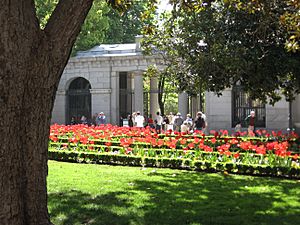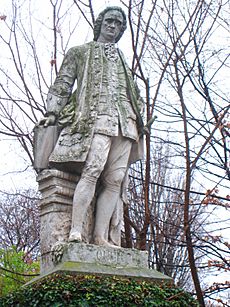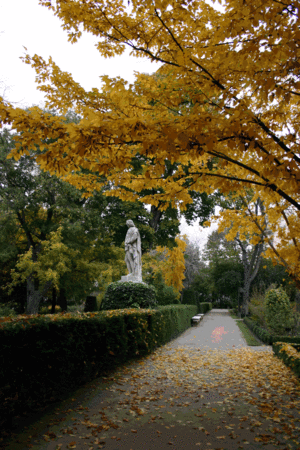Real Jardín Botánico de Madrid facts for kids
Quick facts for kids Royal Botanical Garden |
|
|---|---|
| Real Jardín Botánico | |

The Murillo Gate, the entrance to the Royal Botanical Garden
|
|
| Type | Botanical Garden |
| Area | 8 hectares (20 acres) |
| Created | 17 October 1755 |
| Managed by | Spanish National Research Council |
| Criteria | Cultural: (ii), (iv), (vi) |
| Designated | 2021 (44th session) |
| Part of | Paseo del Prado and Buen Retiro, a landscape of Arts and Sciences |
| Reference no. | 1618 |
| Region | Europe and North America |
| Type | Non-movable |
| Criteria | Historic Garden |
| Designated | 14 October 1942 |
| Reference no. | RI-52-0000019 |
The Royal Botanical Garden of Madrid (in Spanish, Real Jardín Botánico de Madrid) is a special garden in Madrid, Spain. It covers about 8 hectares (which is like 16 football fields!). You can find its main entrance at Plaza de Murillo, right next to the famous Prado Museum. It's a place where you can explore many different kinds of plants from all over the world.
History of the Royal Garden

The Royal Botanical Garden was started on October 17, 1755. King Ferdinand VI created it. It was first located near the Manzanares River. The garden held over 2,000 plants. These plants were collected by a botanist and surgeon named José Quer y Martínez.
In 1774, King Charles III decided to move the garden. He wanted it in its current spot on the Paseo del Prado. This new garden opened in 1781. Architects Francesco Sabatini and Juan de Villanueva designed it. They arranged the plants in three levels, following a system by Carl Linnaeus. This system helps group plants that are alike.
The garden's main goals were to show plants and teach about them. It also helped with trips to find new plant types. There was a special interest in plants from Spain's colonies. In 1794, Alessandro Malaspina brought 10,000 more plants to the garden.
The Spanish War of Independence in 1808 caused problems for the garden. It was left uncared for. But in 1857, a new director, Mariano de la Paz Graells, helped bring it back to life. He added a new greenhouse and fixed up the top part of the garden. He even started a small zoo there! Later, the zoo moved to the Parque del Buen Retiro.
Between 1880 and 1890, the garden faced more challenges. It lost some land to the Ministry of Agriculture. Then, a big storm in 1886 destroyed 564 trees. Since 1939, the garden has been managed by the Spanish National Research Council (CSIC). This is a big science organization in Spain.
Protecting the Garden
In 1942, the garden was recognized as an "Artistic Garden." This means it's a special historical place. After many tough years, the garden closed in 1974. It needed a lot of work to bring it back to its original design. It reopened in 1981, looking beautiful again.
In recent years, the garden became part of a World Heritage Site. This is a special title given by UNESCO. The site is called "Paseo del Prado and Buen Retiro, a landscape of Arts and Sciences." This shows how important the garden is to history and nature.
Exploring the Garden Today
Today, the garden has seven main outdoor areas. It also has five greenhouses. These greenhouses help grow plants that cannot survive Madrid's climate. Madrid has hot, dry summers and cold winters. The garden has about 90,000 plants and flowers, plus 1,500 trees!
Let's look at some of the main outdoor sections:
- Terraza de los Cuadros: This area has plants used for decoration, medicine, and cooking. It also has plants that grow only in Spain. They are planted in neat, square beds around a small fountain. There's even a small Japanese garden here.
- Terraza de las Escuelas Botánicas: This section shows plants grouped by their family. It helps people learn how different plants are related. There are about 12 small fountains in this area.
- Terraza del Plano de la Flor: This part has many different trees and bushes. It was designed in a romantic English style in the mid-1800s. You can find the Villanueva Pavilion here, which was once a greenhouse. There's also a pond with a statue of Carl Linnaeus.
The garden's two main greenhouses are divided into four rooms. The Graëlls greenhouse is very old, from the 1800s. It shows tropical plants and tiny plants called bryophytes. The newer greenhouse has three different climate zones. These zones are tropical, temperate, and desert.
The Herbarium: A Plant Library
The garden also has a huge herbarium. This is like a library of dried plant specimens. It's the biggest one in Spain! It holds over a million plant samples from all over the world. The oldest samples are from science trips in the 1700s and 1800s.
Since 2016, you can find information about many of these samples online. This includes details about algae, mosses, lichens, and fungi.
Science and Publications
The Royal Botanical Garden is not just for looking at plants. It's also a place for science! It publishes several important books and magazines:
- Annals of the Botanical Garden of Madrid: This is a science magazine. It publishes articles about how plants and fungi are classified. It also covers topics like where plants grow and how to protect them.
- Flora Iberica: This is a big project that describes all the wild vascular plants in Spain and the Balearic Islands. By 2018, 20 out of 21 planned books were published.
- Flora Iberica Mycologica: This series focuses on fungi found in Spain. Each book describes different types of fungi. It includes pictures, descriptions, and where they grow.
- Ruizía (Monographs of the Royal Botanical Gardens): These are special workbooks about fungi in Spain.
- Flora Huayaquilensis: This is a collection of old papers. They describe plants found during trips to South America in the late 1700s. A Spanish explorer named Juan José Tafalla Navascués made detailed paintings and notes. These works were hidden for a long time. An Ecuadorian researcher, Eduardo Estrella Aguirre, found them in the garden's archives. He helped publish them, so everyone could see Tafalla's amazing work.
Photo gallery
-
Variedades de calabaza (Variety of cucurbita) in 2016
See also
 In Spanish: Real Jardín Botánico de Madrid para niños Enlightenment in Spain
In Spanish: Real Jardín Botánico de Madrid para niños Enlightenment in Spain





